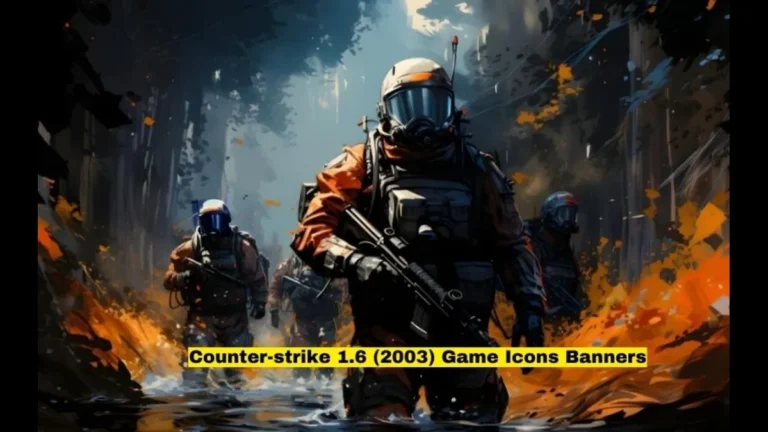When Counter-Strike 1.6 was released in 2003, its sharp tactical gameplay, competitive nature, and tight-knit community helped it become a gaming legend. However, beyond its mechanics and maps, the game’s visual identity—especially its Counter-Strike 1.6 (2003) game icons banners, and other graphics—played a significant role in shaping its legacy. These elements were more than just aesthetic; they helped define the game’s branding, enhance the player experience, and contribute to the development of esports culture.
The Role of Game Icons in Counter-Strike 1.6
The game icons in Counter-Strike 1.6 were minimalist but powerful. These icons, from weapons to objectives, not only streamlined the user experience but also served as an integral part of the gameplay strategy. For instance, icons like the knife, bomb, and defuse kit quickly conveyed essential information. The bomb’s red color, for example, signaled urgency, while the blue Defuse Kit symbolized hope during tense moments. These simple, intuitive designs were crucial during fast-paced rounds, where every second mattered
Moreover, the consistency and clarity of these icons helped build a visual language that players quickly learned to associate with the game. They were instantly recognizable, even outside the context of the game, which played a significant role in fostering the strong Counter-Strike 1.6 community
The Iconography of Weapons: Building Tactical Identity
Weapons in Counter-Strike 1.6 were iconic in more ways than one. From the minimalist silhouettes of the Desert Eagle to the detailed M4A1, each weapon icon was designed to evoke a specific feeling, whether it was the intimidating firepower of an assault rifle or the precision of a sniper. These icons were essential for quick decision-making during matches and symbolized a player’s style, preferences, and skill level.
The weapon icons are also a testament to the “less is more” design philosophy, reflecting the overall simplicity that Counter-Strike 1.6 employed to make its gameplay more intuitive. This simplicity made the game visually accessible and allowed players to focus on tactics rather than overly complex graphics.
Banners: More Than Just Decoration
While icons played a functional role, Counter-Strike 1.6’s banners added a layer of identity and pride to the game. Clans, tournaments, and communities often used these banners to showcase team logos, sponsor advertisements, and player achievements. As esports grew in prominence, these banners helped cultivate an environment of recognition and competition.
The psychology behind banners in Counter-Strike 1.6 was fascinating. They weren’t just decorative; they were tools of community building. Clan banners helped solidify group identities, while custom banners symbolized team loyalty and esports pride. For example, teams like Fnatic or SK Gaming used their banners to establish their branding, which extended to merchandising and media presence. These elements contributed significantly to the rise of esports as a competitive industry.
The Rise of Customization: Community-Driven Banners
One of Counter-Strike 1.6’s hallmarks was the customization options available to players. The ability to create and use custom banners and icons allowed individuals and teams to personalize their experience. Players often crafted banners that displayed their names, logos, and favorite weapons. These custom designs created a sense of ownership and pride, fostering a more engaged community.
Custom banners also played a pivotal role in promoting local tournaments and community events. Players could create banners to advertise their clan’s upcoming battles, making them integral to the vibrant online communities that flourished during the early 2000s. These elements continue to influence modern games, where customization options are a vital feature of player engagement.
The Competitive Edge: Branding and Esports
Visual identity became essential in competitive environments. Teams quickly understood the power of solid branding, and Counter-Strike 1.6 pioneered integrating icons and banners into the fabric of competitive play. During esports tournaments, team icons and banners were visible across the screen, reinforcing the presence and recognition of players and sponsors.
The banners were particularly effective in helping fans and commentators identify teams quickly during live events. This level of recognition became crucial as the game’s esports scene grew, transitioning from local LAN events to major global tournaments. Sponsors also began to realize the value of these in-game spaces as opportunities for advertising, contributing to the commercialization of esports.
The Legacy of Counter-Strike 1.6‘s Visual Elements
Looking back at Counter-Strike 1.6, the visual identity built around its icons and banners was revolutionary. These elements helped define the game itself and the future of gaming aesthetics, particularly in competitive and esports settings. The minimalist design of the icons remains influential, with many modern games adopting similar visual cues to convey information clearly and quickly.
In addition to gameplay and branding, these visual elements contributed to the game’s cultural impact. They helped solidify Counter-Strike 1.6 as more than just a game; they were part of a broader cultural movement celebrating skill, strategy, and community. The game’s icons and banners will continue to serve as a benchmark for future games, especially those in the competitive esports sphere.
Conclusion: The Power of Design in Counter-Strike 1.6
The icons and banners in Counter-Strike 1.6 were essential to the game’s identity and success. From their role in conveying gameplay information to helping foster a sense of community, these visual elements have left a lasting legacy. They were more than just graphical assets—they were tools that helped build a global competitive community. Today, their influence can still be seen in modern esports games, where branding and customization remain core components of the player experience. The visual legacy of Counter-Strike 1.6 has genuinely shaped how we think about game design and its cultural impact on gaming communities.
Read More: Mary Joan Martelly: Empowering Change Through Leadership and Advocacy.


